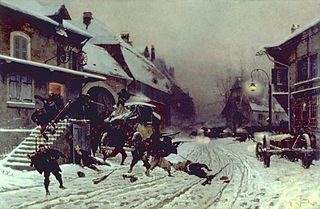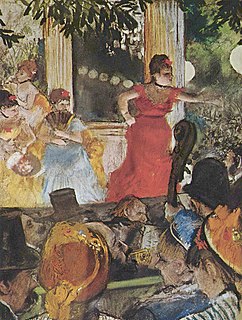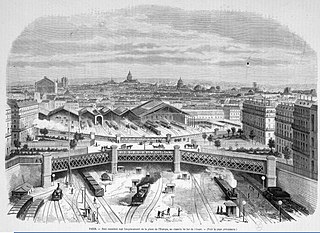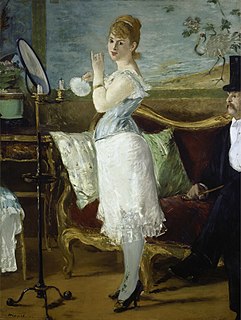 W
WThe Aegean Sea is a c. 1877 oil painting by American artist Frederic Edwin Church, and one of his last large-scale paintings.
 W
WArrival of the Normandy Train, Gare Saint-Lazare, also known as The Railway Station of Saint Lazare in Paris, is a c. 1877 painting by Claude Monet. It is exhibited at the Art Institute of Chicago.
 W
WThe Attack at Dawn by Alphonse de Neuville is a painting by French painter Alphonse de Neuville, from 1877. The painting depicts a French town under siege by Prussian troops during the Franco-Prussian War.
 W
WThe Beguiling of Merlin is a painting by the British Pre-Raphaelite painter Edward Burne-Jones that was created between 1872 and 1877.
 W
WBoating on the Yerres is a 1877 painting by French impressionist and realist painter Gustave Caillebotte.
 W
WCafé-Concert at Les Ambassadeurs is a monotype pastel by Edgar Degas of the cafe-concert at the Les Ambassadeurs restaurant. It was first exhibited in 1877 at an Impressionist exhibition and is now in the Musée des Beaux-Arts de Lyon. A later non-monotype version from 1885 is now in the Musée d'Orsay.
 W
WThe Cemetery is an 1877 painting by Swedish artist Carl Fredrik Hill. The painting is currently on display at the Malmö Art Museum in Sweden.
 W
WThe Cobbler's Apprentice is a painting by the American painter Frank Duveneck, painted in 1877. It hangs in the Taft Museum of Art of Cincinnati, Ohio, United States. The oil on canvas portrait measures 38.5 by 26.75 inches and it is signed by the artist.
 W
WCôte des Bœufs at L'Hermitage is an oil-on-canvas landscape painting by the French Impressionist artist Camille Pissarro. It was painted in 1877, and displayed the same year at an exhibition now generally referred to as the third Impressionist exhibition. The picture is large by Pissarro's measure, and he described the effort of painting it as the ‘work of a benedictine’. Pissarro was proud of the painting, and it remained in his family's possession until 1913. It presently hangs in the National Gallery, London.
 W
WCromwell, Protector of the Vaudois (1877) is a painting by Ford Madox Brown which depicts Oliver Cromwell in conversation with John Milton dictating a letter to Andrew Marvell protesting at the Piedmontese Easter massacre (1655), an attack on the Vaudois (Waldenses), a persecuted Protestant sect in Piedmont, northern Italy. It was Brown's second Cromwell painting, following Cromwell on his Farm (1875).
 W
WDoña Joanna the Mad is an 1877 oil on canvas painting by the Spanish painter Francisco Pradilla. It is now in the Museo del Prado in Madrid, Spain.
 W
WDressing for the Carnival is an 1877 painting by the American painter, printmaker and illustrator Winslow Homer.
 W
WThe Gallery of HMS 'Calcutta' (Portsmouth), also known as Officer and Ladies on Board HMS Calcutta, is an 1876 oil painting by James Tissot. It depicts two ladies in fashionable clothing and a young naval lieutenant, standing on the quarter gallery at the stern of the Royal Navy warship HMS Calcutta. The painting is held by the Tate Gallery in London and measures 68.6 by 91.8 centimetres.
 W
WAfter working on rural landscapes, Claude Monet returned to Paris in 1877 and made a dozen oil paintings of the Gare Saint-Lazare railway station in Paris. This was Monet's first series of paintings concentrating on a single theme.
 W
WGloucester Harbor is a late 19th-century painting by American artist William Morris Hunt. Done in oil on canvas, the impressionist painting depicts morning in the harbor of Gloucester, a major fishing port in New England. The painting was one of Hunt's first forays into the school of impressionism, and the creation of Gloucester Harbor and several other impressionism-inflected works sparked Bostonian interest in the impressionist movement. The painting is currently on display at the Museum of Fine Arts.
 W
WHaymaking or Resting in the Fields is an 1877 painting by Jules Bastien-Lepage. First exhibited at the 1878 Paris Salon, it was acquired by the Musée du Luxembourg in 1885 at the posthumous sale of the artist's works. It passed to the Louvre in 1929 and then to its current home in the Musée d'Orsay in 1980.
 W
WLove and the Maiden is a tempera on canvas by English Pre-Raphaelite artist John Roddam Spencer Stanhope, executed in 1877 and currently housed at the Fine Arts Museums of San Francisco.
 W
WNana is a painting by French painter Édouard Manet. It was completed in 1877 and was refused at the Salon of Paris the same year. Manet decided to show his painting it in the window of a shop on the Boulevard des Capucines, one of Paris’s main street. The painting gathered attention and crowds during its exhibition, due to Manet's fame in Paris. The work is now at the Kunsthalle Hamburg art museum in Germany.
 W
WParis Street; Rainy Day is a large 1877 oil painting by the French artist Gustave Caillebotte (1848–1894), and is his best known work. It shows a number of individuals walking through the Place de Dublin, then known as the Carrefour de Moscou, at an intersection to the east of the Gare Saint-Lazare in north Paris. Although Caillebotte was a friend and patron of many of the impressionist painters, and this work is part of that school, it differs in its realism and reliance on line rather than broad brush strokes.
 W
WPlum Brandy, also known as The Plum, is an oil painting by Édouard Manet. It is undated but thought to have been painted about 1877. The painting measures 73.6 centimetres (29.0 in) by 50.2 centimetres (19.8 in). It depicts a woman seated alone at a table in a cafe, in a lethargic pose similar to that of the woman in Degas' L'Absinthe. The woman may be a prostitute, but unlike the subject of Degas' work she appears more dreamy than depressed. She holds an unlit cigarette and her plum soaked in brandy appears untouched.
 W
WPortsmouth Dockyard is an 1877 oil painting by French artist James Tissot. It is a reworking of his 1876 painting On The Thames, which also depicts a man and two women in a boat. It measures 15.0 by 21.5 inches.
 W
WThe Reading is a painting by French painter Henri Fantin-Latour in 1877. It was acquired in 1901 by the city of Lyon and by the Musée des Beaux-Arts de Lyon where it is currently conserved.
 W
WEl Rio de Luz is an 1877 oil painting by American landscape artist Frederic Edwin Church. It is his last large-scale painting of South America, following pieces such as The Andes of Ecuador (1855) and The Heart of the Andes (1859). Like them, the painting is a composite of the many sketches and drawings Church made while traveling in South America twenty years earlier.
 W
WA Sea–Spell is an 1877 oil painting and accompanying 1869 sonnet by English artist Dante Gabriel Rossetti, depicting a siren playing an instrument to lure sailors. It is currently on display in the Harvard Art Museums in Cambridge, Massachusetts.
 W
WThe Wolf of Gubbio is an 1877 oil on canvas painting by Luc-Olivier Merson, dedicated to his former student, collaborator and friend Adolphe Giraldon and exhibited at the Paris Salon of 1878. It was acquired by its present owner, the Palais des Beaux-Arts de Lille, in 1881. It is inspired by a legend of Francis of Assisi and the wolf of Gubbio in Italy.